Article is updated: October 10, 2025
You ever tried finding a single, tiny screw in a warehouse the size of a football field? That’s IT asset management without the right system. One minute, everything’s running smooth. The next? Chaos.
A server you swore was decommissioned just sprang back to life, licenses are expiring like milk in the sun, and someone — someone — just spun up a fleet of shadow resources in the cloud. Again.
Here’s the deal: In 2025, managing IT assets isn’t about keeping up — it’s about staying ahead.
Visibility isn’t a luxury. It’s survival.
Automation isn’t a bonus. It’s oxygen.
And when your infrastructure spans on-prem, multi-cloud, and “who even owns this?” territory, you need asset management software with features that don’t just track assets — they predict, optimize, and keep the whole machine running like a symphony.
So, let’s talk shop. Here’s how to choose the right asset management software — 15 must-have features for an ITAM solution that actually works.
Must-have ITAM features (what we’ll cover & why they matter)
| Feature we’ll cover | Why it matters (outcome) |
|---|---|
| Centralized asset repository | One living inventory across on-prem + clouds so owners, versions, and audit answers are findable in seconds—no spreadsheets. |
| Automated real time IT asset discovery | Kill blind spots fast with org-level cloud collectors and K8s awareness; stay ahead of shadow resources instead of reconciling after the fact. |
| Tagging & Virtual Application Grouping | Enforce owner/application/env/cost-center and group infra into app/service views so costs, risk, and ops map to real teams. |
| Related items | CMDB relationships make blast-radius and root cause instant: see upstream/downstream dependencies when something bends. |
| Change management | Immutable per-CI “who/what/when” + diffs cut MTTR and satisfy audits without witch hunts. |
| Software License Management | Stop over-deployment and zombie seats; reclaim licenses with evidence (last activity, assignment history). |
| Compliance Tracking | Turn “prove it” into one click: control → asset/CI → test/result → timestamp for PCI/SOC2/HIPAA. |
| Lifecycle States & Clean Decommission | Prevent orphaned, risky, or costly leftovers; policy-driven retire/wipe with traceable evidence. |
| Cost Management | Allocate ≥90% of cloud cost to apps/services; auto-flag idle/oversized resources before bills spike. |
| Incident & Ticketing System Integration | Signals become accountable work: owner-mapped, env-aware tickets with CI links and impact context. |
| Role-based access control | Least-privilege by persona and scope so Finance sees spend, SecOps sees risk, App Owners see their services. |
| Audit Logs | Full accountability trail for sensitive actions across accounts, services, and environments. |
| Vulnerabilities scanning (refocused as “Vulnerability Data Join”) | Ingest findings, map to CIs/services, prioritize by blast radius, and route to owners — less noise, faster fixes. |
| Customizable Dashboards & Advanced Analytics | One home for FinOps/SecOps/App Owners; saved, shareable views without spreadsheet sprawl. |
Let's dive into the details 👇
Centralized asset repository
You know the drill — assets scattered across on-prem racks, multiple clouds, and a graveyard of forgotten instances someone spun up six months ago. Finding anything feels like spelunking through an undocumented cave system. That’s where a Centralized Asset Repository comes in.
It’s not just a database. It’s the backbone of an IT asset management software system — a living inventory that auto-syncs across environments, mapping every server, VM, container, and license to its rightful place. Whether it’s an EC2 instance in AWS, a Kubernetes pod in GCP, or a dusty old hypervisor humming away in a forgotten corner of your data center, it’s all tracked, categorized, and actually visible.
Now, imagine an urgent compliance audit lands on your desk. The security team needs proof that none of your workloads are running outdated OS versions. Without a centralized repository? You’re digging through fragmented logs, juggling Terraform states, and hoping nothing was provisioned outside the pipeline.
With a robust asset management solution? Query your software system in seconds, pull up a compliance report, and move on with your life.
This isn’t just about tracking data. It’s about controlling assets, optimizing costs, and making sure your IT asset management software features actually work for you — not against you.
Automated real time IT asset discovery
IT assets don’t wait for inventory updates. A new EC2 instance appears in AWS, an untagged Kubernetes pod lingers in GCP, someone provisions an Azure SQL database at 2 AM “just for testing” and forgets about it. Meanwhile, a physical server is relocated across the data center without a record.
If you’re still relying on manual checks, your management system is already behind.
Automated Asset Discovery is always on. It’s a real-time scanning engine, continuously mapping everything — cloud instances, on-prem hardware, IoT devices — detecting new assets the second they connect. It scans networks, pulls data, and categorizes each asset by IP address, MAC address, or software signature.
Cloud-based? It hooks into AWS, Azure, and Google Cloud APIs.
Now, imagine an audit lands. You need proof of every asset’s location and status. Without automated discovery, you’re drowning in spreadsheets.
With it? Your IT asset management software features work for you — every asset is tagged, tracked, and monitored in real-time, feeding accurate data into your management software system for complete control. No blind spots, just solutions that keep your infrastructure in check.
Tagging & Virtual Application Grouping
Environments don’t stay small. What starts as a neatly defined architecture quickly turns into an ever-expanding galaxy of VMs, containers, databases, and serverless functions — some actively managed, others orphaned in the void. Without Tagging & Virtual Application Grouping, tracking anything beyond day one becomes a mess.
A good IT asset management software system doesn’t just let you tag resources — it enforces structure across multi-cloud and on-prem environments. Cloudaware, for example, lets you:
- Group assets into virtual applications. Tie every VM, Lambda function, RDS instance, and load balancer to the relevant application.
- Enforce standardized tagging policies. Ensure every resource has the right metadata (owner, environment, cost center).
- Separate environments with precision. Keep dev, staging, and production isolated at the metadata level.
Now, let’s say the Prod team detects latency in a critical customer-facing app. They ping DevOps, who need to pinpoint whether the issue is in the database, an API, or a rogue microservice. Without virtual application grouping, they’re jumping between logs, scraping resource lists, and hoping to track dependencies manually.
With it? They pull the app-level view instantly, seeing every connected asset, its health status, and recent changes.
Root cause? An unoptimized query in an autoscaled RDS cluster.
This isn’t just labeling — it’s operational clarity, cost efficiency, and one of the best IT asset management software features for turning scattered data into actionable insights.
Read also: FinOps vs DevOps - How to Make Them Work Together
Related items
An IT infrastructure isn’t just a collection of assets — it’s a web of dependencies. A VM isn’t just a VM. It’s tied to a storage volume, a security group, a database, an API gateway, and a dozen other components.
Miss one connection? You’re blind to the ripple effects of every change.
That’s where Related Items come in.
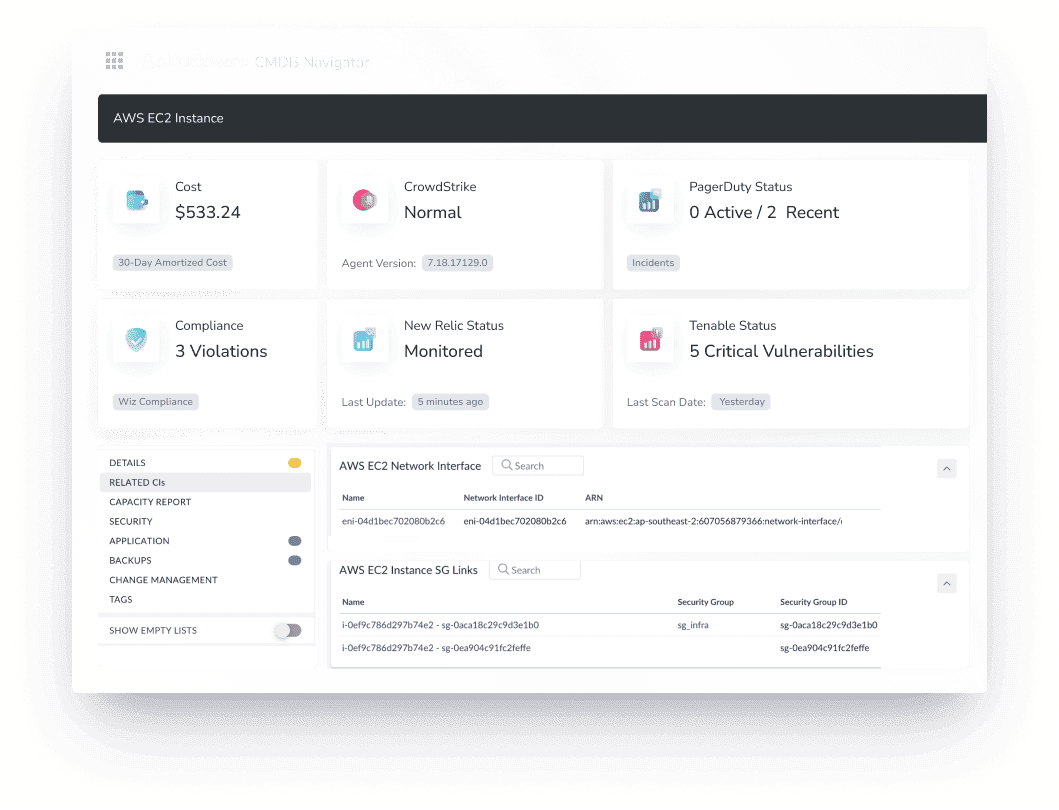
Here is an example of how it looks like in Cloudaware.
A good IT asset management software system doesn’t just track assets — it maps relationships in real time. With Related Items, you can:
- See upstream and downstream dependencies. Know what breaks if an instance goes down.
- Trace security risks. Spot exposed VMs linked to outdated security groups.
- Speed up troubleshooting. View connected resources without digging through multiple consoles.
Now, imagine a dev team decommissions a VM, assuming it’s unused. Hours later, an entire service fails. No logs, no alerts — just downtime. With Related Items, the link to a forgotten API backend would’ve been instantly visible. No firefighting, no guesswork — just data-driven control over your infrastructure.
Change management
A security group rule gets updated, a workload is migrated, an autoscaler configuration shifts. And somewhere in that constant motion, something goes wrong. A production outage. A compliance violation. A missing audit trail that turns a simple rollback into a full-blown crisis.
That’s why Change Management isn’t optional — it’s the watchtower keeping IT environments under control. A strong asset management system doesn’t just log what changed — it shows who changed it, when, where, and why.
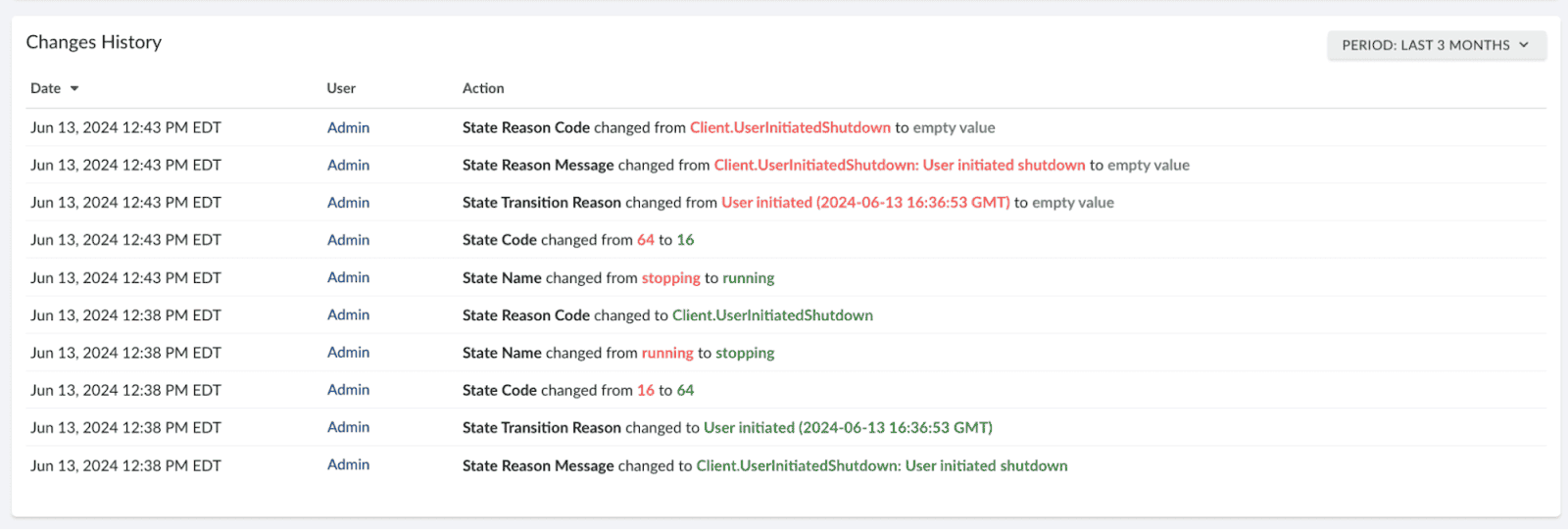
The change management history in Cloudaware.
With change tracking in place, IT teams can:
- Monitor all modifications to IT assets. Whether it’s a VM, network rule, or cloud resource.
- Enforce approval workflows. Ensure that high-risk updates go through the right channels.
- Compare past configurations. Prevent system drift before it disrupts operations.
Let’s say a routine Terraform deployment finishes, but suddenly, an API fails. No alerts, no obvious logs — just a broken service. Without a management system for changes, you’re stuck guessing. With change tracking, you instantly see that a network policy update was pushed just minutes before the failure. A rollback is triggered, service restored, and instead of spending hours debugging, you’re back on track in minutes.
Change isn’t the problem — untracked change is. And in a hybrid IT environment, where facilities, equipment, and IT assets are constantly evolving, management software with built-in compliance solutions is the only way to keep operations stable.
Software License Management
Licenses aren’t just paperwork — they’re rules, limits, and risks baked into your software stack. Deploy beyond your entitlements, and you’re in violation. Fail to renew on time, and critical tools grind to a halt. Software License Management is the governance layer that prevents both.
A proper IT asset management system enforces usage policies across every deployment. Here’s what it does:
- Monitors license entitlements. Tracks purchased vs. deployed assets in real-time.
- Prevents unauthorized installations. Flags over-deployed or unlicensed software.
- Automates renewal and expiration alerts. Ensures compliance without last-minute scrambles.
Just imagine a DevOps engineer spinning up a new analytics tool in a sandbox. It’s licensed per CPU core, but scaling wasn’t restricted — so it balloons. Without license tracking, costs skyrocket, and compliance is breached. With the right management software solutions, the system automatically detects the violation, enforces the limit, and blocks overuse before it becomes a financial or legal nightmare.
Among the best IT asset management software features, software license management is the safety net that keeps assets in check, data clean, and operations compliant.
Compliance Tracking
You know what keeps security teams up at night? Not the risks they see — it’s the ones hiding in plain sight. The IAM policy that got a little too generous. The storage bucket left open to the internet. The certificate that expired quietly over the weekend. And when your assets are spread across cloud, on-prem, and everything in between, staying compliant isn’t just an item on the checklist — it’s an always-on mission.
That’s where Compliance Tracking comes in.
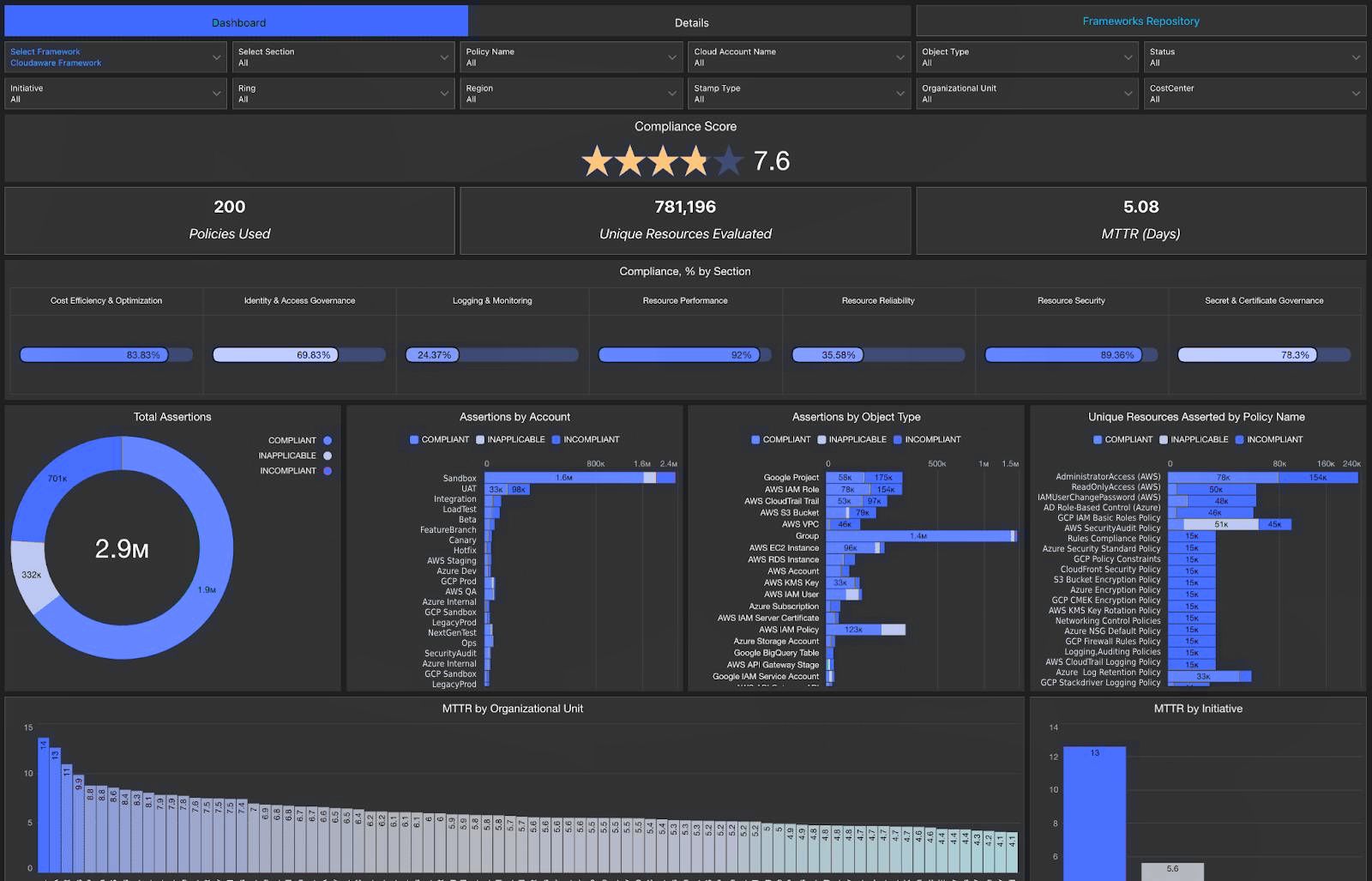
This is how the compliance audit report looks like in Cloudaware.
No more scrambling for audit reports or manually checking security configs. A solid IT asset management software system keeps everything in check, in real-time, ensuring:
- Every asset follows security and compliance policies. Whether it’s CIS, GDPR, SOC 2, HIPAA, or internal governance.
- Misconfigurations get flagged the second they appear. No more exposed S3 buckets slipping through unnoticed.
- Fixes happen fast. Either automatically or through pre-approved workflows.
Now, imagine security pings you: an API gateway is using outdated TLS settings. Without compliance tracking, you’re digging through logs, manually reviewing data, and hoping nothing else got misconfigured. With it? The system already detected the drift, logged it, and pushed a fix before anyone even noticed.
This isn’t just about staying compliant. It’s about using the best IT asset management software features to turn compliance from a headache into an automated, proactive solution.
Lifecycle States & Clean Decommission
You ever stumble across a VM that’s been running way too long — untagged, quietly racking up costs? Or worse, a legacy database still holding customer data, completely exposed because someone forgot it even existed? That’s what happens when maintenance and lifecycle management aren’t locked down.
Nobody has time to manually track assets across multi-cloud and on-prem environments. That’s why Automated Maintenance & Lifecycle Management is non-negotiable. A solid IT asset management software system keeps your infrastructure clean, secure, and cost-efficient without the manual overhead. The best solutions include:
- Lifecycle enforcement. No forgotten workloads sitting idle, burning budget.
- Controlled decommissioning. The system flags outdated resources and initiates cleanup.
Here is an example of the dashborad with upgradable packadges in Cloudaware:

Now, imagine a zero-day vulnerability drops. Security needs to know if any production assets are affected. Without lifecycle tracking, you’re manually checking versions, digging through logs. With it? The management software already flagged non-compliant instances, or spun up replacements.
This isn’t just about maintenance — it’s about staying ahead instead of cleaning up after the mess. If you want to choose the right asset management software, make sure lifecycle automation is built in.
Cost Management
Budgets don’t explode all at once — they leak. A zombie instance here, an oversized database there, a fleet of test containers still running long after the sprint ended. And when your assets are spread across multi-cloud, on-prem, and everything in between, keeping spending under control without sacrificing performance takes more than skimming billing reports.
That’s where Cost Management earns its keep.
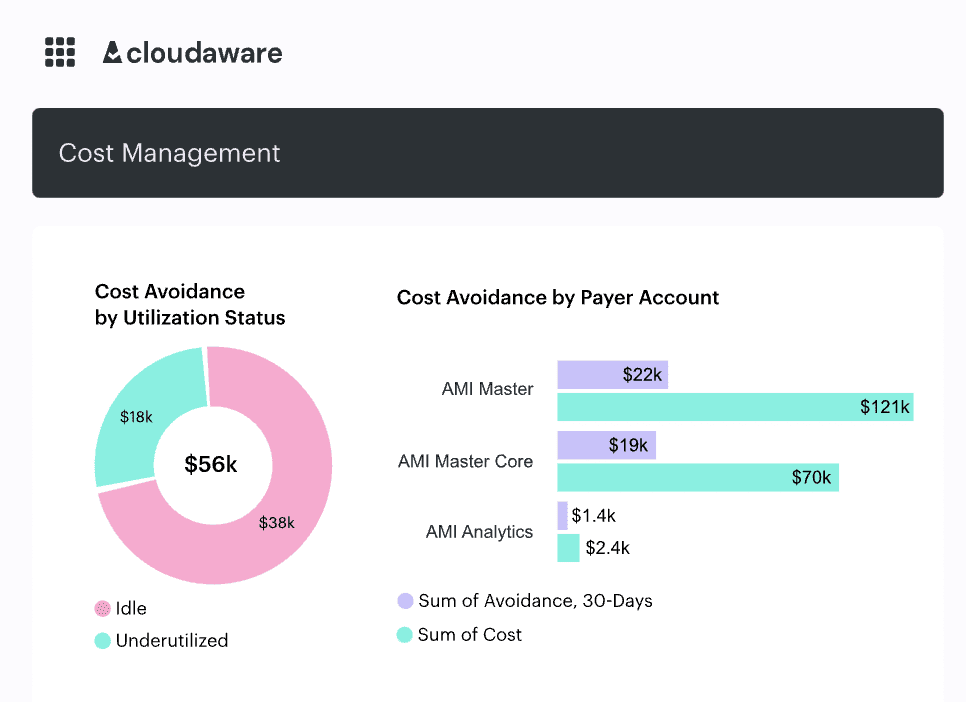
An example of the FinOps dashboard in Cloudaware.
A strong IT asset management software system doesn’t just track spend — it optimizes it before waste spirals out of control. The best solutions include:
- Cost allocation by team, project, or app. Every charge is mapped, no surprises.
- Automated waste detection. Flags idle assets, oversized VMs, and forgotten storage volumes.
- Predictive spending analysis. Identifies potential budget overruns before they hit.
Now, finance pings you: last month’s cloud bill spiked 30%. No major deployments, no planned scale-ups — so where’s the drain? Without cost tracking, you’re sifting through data, manually hunting anomalies.
With it? The management software already flagged a batch of GPUs left running after a load test. One click, they’re gone, and the budget’s back on track.
This isn’t about cutting costs — it’s about spending smart. When cost visibility is built into your IT management system, you’re not reacting to surprises — you’re preventing them before they happen.
Incident & ticketing system integration
When something bends—tag policy drifts, a K8s namespace slips out of discovery, unallocated cloud cost spikes—you don’t want humans triaging screenshots. You want owner-mapped, environment-aware tickets created with CI context the second a rule fires.
What good looks like:
- Auto-tickets with full context: On policy trigger (tag drift, coverage gap, cost anomaly, vuln on prod CI, zombie asset), create an issue in Jira or ServiceNow (others via webhook/API). Payload includes CI/Service link, owner, environment (dev/test/prod), blast radius (related items), and evidence (metrics/findings).
- Workflow-driven resolution: Enforce approvals for prod actions (reboot, IAM change). Time-box exceptions with auto-reminders and audit trails.
- Bi-directional sync: Status/comments sync back to the CI and dashboards so what’s “Done” in Jira is done in ITAM.
- Runbook pointers: Every ticket carries the right SOP link so on-call doesn’t guess.
🚨 Example Slack Alert:
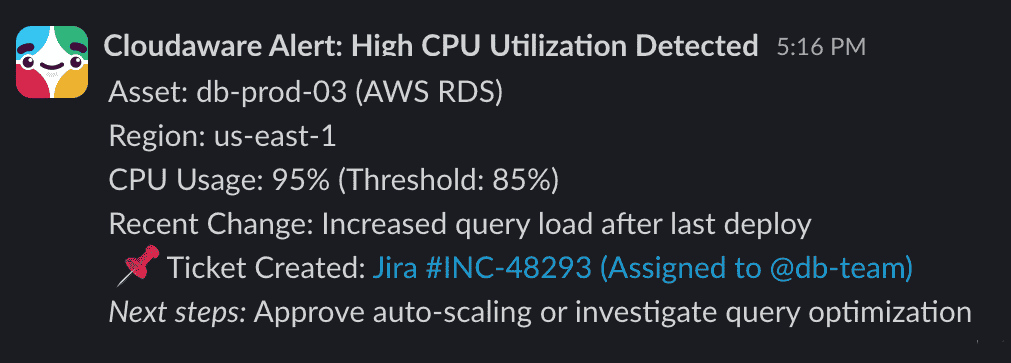
Why this matters:
- Turns signals into accountable work tied to the CMDB model—apps, services, owners—so fixes land where the budget and risk actually live.
- Eliminates swivel-chair ops and keeps remediation measurable (MTTA/MTTR, % allocated cost, tag compliance).
What to verify in a demo:
- Ticket payload includes CI/Service link, owner, env, blast-radius graph, and evidence; created automatically on trigger.
- Routing auto-assigns by owner/env; supports Jira/ServiceNow (others via webhook/API).
- Bi-directional sync of status/comments; ticket ID visible on the CI; closure reflects in dashboards.
- Governance: Required approvals for prod changes; exceptions have TTL; complete audit history retained.
Role-based access control
When your estate spans AWS/Azure/GCP, on-prem, SaaS, and K8s, you can’t have every persona seeing cost, owners, or prod configs. RBAC enforces least-privilege across ITAM so Finance sees showback, SecOps sees risk, App Owners see their services—without crossing wires.
Why it matters:
- Least-privilege by persona (FinOps, SecOps, DevOps, App Owners, Auditors) and by scope (account/subscription, app/service, environment).
- Data domain controls: cost fields, owner PII, compliance evidence, and change history gated by role.
- Operational safety: no accidental edits to tags, CIs, or shared-cost policies.
- Auditability: immutable change log + who-touched-what/when.
What good looks like:
- Role definitions map to SSO groups (Okta/Entra), optional SCIM user provisioning.
- Scope filters on every saved view (env/app/BUs) + field-level permissions for sensitive attributes (cost, owners).
- API tokens bound to roles/scopes; rotation & expiry policies.
Acceptance criteria (use in your RFP/demo):
- Show a least-privilege role that can view CI inventory and costs for one service in one environment, but cannot edit tags or cost policies.
- Prove field-level restrictions (hide cost data for non-FinOps).
- Show audit logs of role changes + access attempts; exportable.
- Demonstrate SSO group → role mapping and token scoping for API calls.
Demo ask
“Create a read-only App Owner role scoped to
prodfor Service X; show they can see CIs and costs for that service only, then try (and fail) to edit tags or view another team’s costs. Export the access audit.”
Audit logs
Okay, you know those times when something breaks, and you have no idea where it started? Maybe someone pushed a change, and now everything is acting up. That’s where Audit Logs become your best friend.
In a hybrid cloud setup, when things span across AWS, Azure, GCP, and on-prem, knowing exactly who did what and when can save your life. It’s like having a trail of breadcrumbs that always leads you back to the culprit — whether it’s a misconfigured instance, a forgotten permission change, or an accidental deletion.
Here’s how it helps:
- Track every action. Who added what permissions? Who accessed that asset?
- Ensure accountability. When something goes wrong, you can point directly to the asset change or action.
- Support audits. Regulatory check? No problem. You’ve got the data.
So, picture this: the DevOps team deployed a new service across a few cloud accounts, and now there’s some weird latency issue. You dive into the audit logs and see exactly when the config change happened and who made it.
The issue? A database connection wasn’t properly set up. Problem solved.
Audit logs are one of the most essential features of asset management software. They ensure that you have full visibility into what’s happening with your assets, help keep everything accountable, and make managing your system smooth.
Vulnerabilities scanning
We’re not pretending your ITAM runs a scanner. It ingests findings from the tools you already trust (Qualys, Tenable, cloud-native, etc.), maps them to CIs/services in the CMDB, and routes work to the right owners with context. That’s the difference: less “big scary list,” more “who owns it and what breaks if we don’t fix it.”
Here is an example of the Vulnerability Scanning report element from Cloudaware:
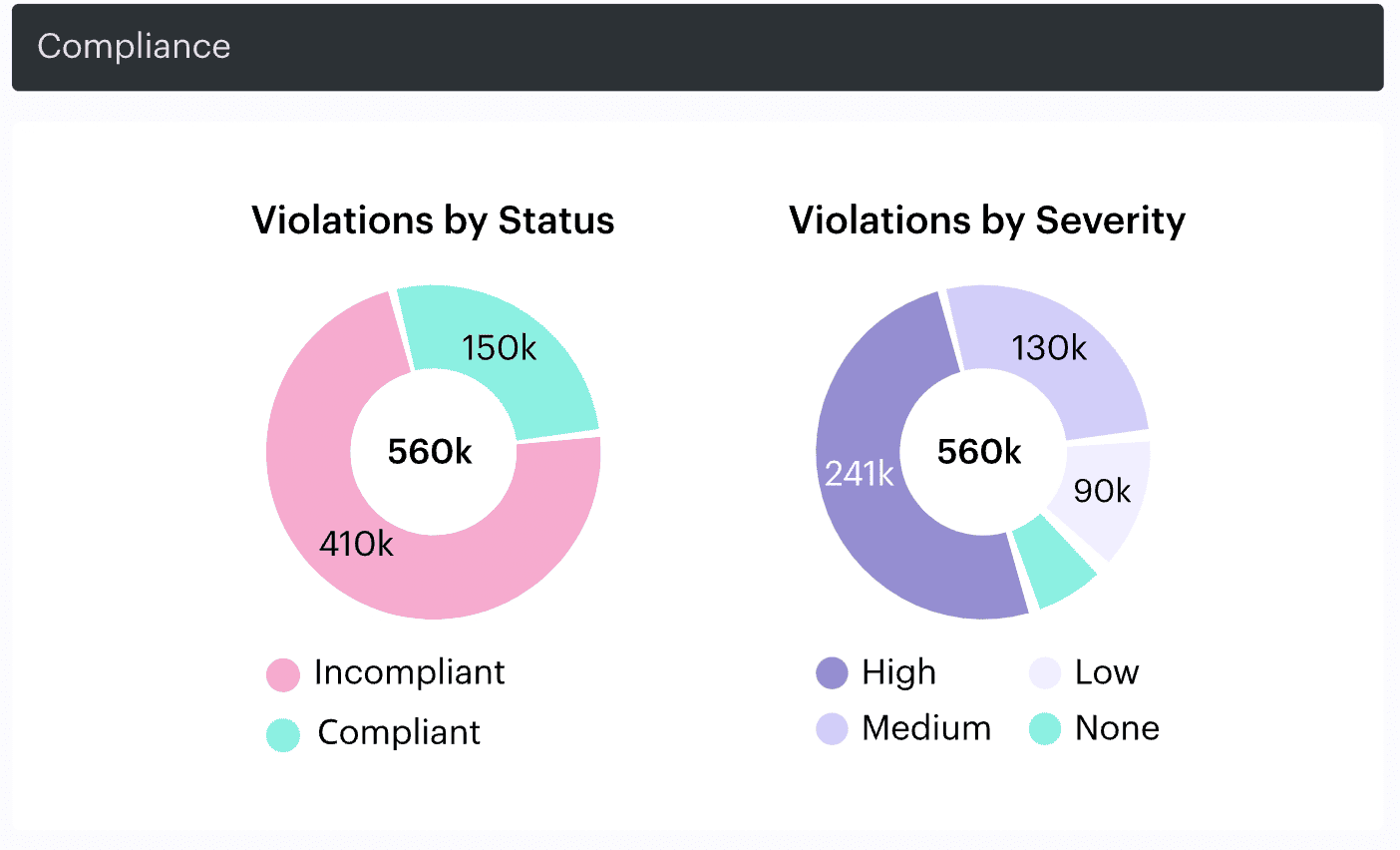
What it does:
- Normalize & enrich: Pull vuln findings, dedupe, and attach them to the right CI (host, container image, function) and service/app via CMDB relationships.
- Prioritize by blast radius: Rank by service criticality, environment (dev/test/prod), exposure, and CVSS—so prod customer APIs beat dev sandboxes every time.
- Route with evidence: Auto-create tickets (Jira/ServiceNow) to the service owner with the CI link, recommended fix, and related items to show impact.
- Prove it for audit: One-click export: control → asset/CI → test/result → timestamp for PCI/SOC 2/HIPAA narratives.
Why it matters: You cut through scanner noise and answer the only questions leaders care about: Which service is at risk? Who owns it? What’s the ETA?
Acceptance (use in demos/RFP)
- Findings ingested and attached to CIs/services (not just IPs/hostnames).
- Service-level view shows open vulns by severity with drill-down to host/container image.
- Owner-mapped routing with bi-directional sync; ticket includes CI link, environment, and blast radius.
- Exportable evidence (CSV/PDF) for audits with timestamps and status history.
Fast KPI targets
- Time-to-owner: < 15 minutes from ingestion to routed ticket
- Service coverage: ≥ 95% of findings mapped to a CI/service
- Closure hygiene: ticket closure auto-reflects in CI status/evidence export
TL;DR: keep scanning in SecOps. Let ITAM join, enrich, and drive accountability so risk lands on the right desk—with the context to fix it.
Customizable dashboards & advanced analytics
Now you know how everything’s scattered across AWS, Azure, GCP, and on-prem, right? It's like a million moving parts, and keeping track of assets and their performance feels like you're always chasing down issues in a maze. That’s where Customizable Dashboards & Advanced Analytics become a game-changer. They’re like your personal mission control for all things cloud and on-prem, giving you full visibility over asset management.
Here’s the magic:
- You can customize dashboards to pull in just the data that’s relevant to you — whether it's costs, asset usage, or compliance.
- You can spot patterns or anomalies in real-time, which means early warnings for things like rogue resources or unexpected bill spikes.
- You can easily drill down into a specific asset, see exactly what's happening, and make informed decisions — no digging through pages of logs.
But here’s the real kicker — easy audit reports for every part of your infrastructure workflow. From compliance reports to vulnerability scans to cost optimization, you can generate reports in a few clicks.
So, let’s say we had that cost spike last week. Instead of hunting down the source, I pulled up a custom dashboard, saw the unused EC2 instances, and then created a quick report on cost savings after turning them off. It’s all part of the features of asset management software. Tracking your equipment, optimizing your assets, and gaining actionable insights with no extra effort. Instant visibility across the board, no more headaches.
RFP checklist & questions to ask vendors
You’re not shopping for a pretty dashboard. You’re buying a source of truth for ITAM across cloud, SaaS, endpoints, and K8s. Use these questions verbatim in demos and POCs. Each one has acceptance criteria so you can score vendors on evidence, not promises.
Coverage & source of truth
- Show discovery coverage across AWS/Azure/GCP orgs, on-prem, and K8s.
Acceptance: A gap report comparing discovered vs. expected assets by account/subscription/cluster with ≥95% coverage in 30 days. Must include clusters → namespaces → workloads and node/Pod mapping. - Prove SaaS discovery via IdP (Okta/Entra/Google Workspace).
Acceptance: Exportable list of apps → users → status (active/disabled/last activity), plus unattested apps. Seat/utilization fields visible. - Demonstrate normalization & deduplication across collectors.
Acceptance: One CI per asset/service with canonical IDs; provenance retained; merge/suppress rules shown; drift report available. - Show CMDB modeling of services/apps/environments.
Acceptance: Relationship graph from infra → app/service with owner, env (dev/test/prod), business unit, and criticality; clickable “related items” path.
Ownership, cost & utilization
You don’t need another inventory list — you need levers. This block is where ITAM meets FinOps and actually moves spend, ownership, and hygiene in your multi-cloud + K8s + SaaS stack.
- Enforce cloud tags & K8s labels (fix a bad tag live). Make tagging boringly consistent across AWS/Azure/GCP accounts, subscriptions, clusters, and namespaces.
Acceptance: Required keys (cost-center,application,owner,env) enforced org-wide; non-compliant resources/workloads flagged with drift alerts; one-click remediation (Jira/ServiceNow) updates the asset and bumps tag compliance % in the report within minutes. - Allocate cloud cost & showback by CI/app/service. Roll instance noise up into service costs your owners will actually accept and act on.
Acceptance: % allocated cloud cost ≥90% for in-scope; shared-cost policies configurable; rollups by application/service/environment with owner visibility; exportable ledger for finance and FinOps. - Reclaim underused SaaS licenses (IdP-driven). Pull seats and usage straight from Okta/Entra/Google Workspace and trigger cleanup.
Acceptance: Low-usage thresholds configurable; stale seats identified with last activity evidence; auto-ticket created to the right app owner; reclaimed seat count and $ saved surfaced in the dashboard. - Kill zombie/idle resources & rightsize what’s noisy. Shut down the lights where no one’s home; trim what’s oversized.
Acceptance: Idle VMs/volumes/DBs and underutilized K8s workloads detected with CPU/mem/IOPS evidence; policy-driven actions or routed tickets; each finding shows a $ impact estimate and post-action verification.
What good looks like (fast KPIs to track):
- Tag/label compliance: ≥90% of in-scope resources/workloads in 30 days
- Allocated cloud cost: ≥90% mapped to services/apps
- SaaS reclamation: ≥10–20% unused seats retired in first quarter
- Idle/rightsized savings: measurable $ impact reported per action, auto-summed monthly
Proof to request in the demo: a coverage & tag-compliance dashboard, one real-time tag fix, a showback view by service with shared-cost rules, an IdP-based SaaS cleanup ticket, and an idle/rightsize report with before/after savings.
Risk, compliance & evidence
- Join vulnerability data to assets and roll up by service.
Acceptance: Service-level risk view; drill-down to host/container image; CVSS/CWE fields present; owner mapped for routing. - Export audit-ready evidence mapped to PCI/SOC 2/HIPAA controls.
Acceptance: One-click export (CSV/PDF) showing control → asset/CI → test/result → timestamp; includes file integrity/log inspection trails where applicable. - Show immutable change history & RBAC.
Acceptance: Per-CI change log (who/what/when), role-based access with least-privilege policies, and tamper-evident audit logs.
Automation, integrations & extensibility
- Route incidents/violations to Jira/ServiceNow with context.
Acceptance: Ticket contains CI link, owner, env, blast radius, and runbook pointer; status syncs bi-directionally. - Alert on tag drift, coverage gaps, and cost anomalies.
Acceptance: Policy thresholds configurable; suppression windows; owner-mapped notifications; evidence attached. - Prove API/ETL depth for data export.
Acceptance: Documented endpoints; sample call returning asset + cost + owner + compliance fields; throughput limits and pagination disclosed. - Show role-based dashboards & stakeholder views (FinOps, SecOps, App Owners).
Acceptance: Saved views per persona; shareable, versioned; row-level filtering by environment/business unit.
Reporting & governance
- Deliver a quarterly governance pack.
Acceptance: Out-of-the-box report with discovery coverage trend, tag compliance %, % allocated cost, top unallocated spend, open risk items by service, and SLA on remediation.
Use this table to score vendors during demos
Create a quick scoring sheet with 0–2 per question:
- 0 = hand-waving or partial screenshots
- 1 = demoed but missing acceptance detail/export
- 2 = demoed with exports + policy/routing live
| # | Question | Acceptance criteria | Evidence shown | Meets acceptance (Y/N) | Notes | Score (0–2) |
|---|---|---|---|---|---|---|
| 1 | Show discovery coverage across AWS/Azure/GCP orgs, on-prem, and K8s. | Gap report with discovered: expected by account/subscription/cluster ≥ 95% within 30 days; includes K8s clusters → namespaces → workloads with node/Pod mapping. | ||||
| 2 | Prove SaaS discovery via IdP (Okta/Entra/Google Workspace). | Exportable list of app → user → status (active/disabled/last activity) + unattested apps; seat/utilization fields visible. | ||||
| 3 | Demonstrate normalization & deduplication across collectors. | One canonical CI per asset/service; provenance retained; merge/suppress rules shown; drift report available. | ||||
| 4 | Show CMDB modeling of services/apps/environments. | Relationship graph infra → app/service with owner, env (dev/test/prod), business unit, criticality; clickable related items path. | ||||
| 5 | Enforce tag/label policy and fix a bad tag live. | Required keys (e.g., cost-center, application, owner, env) enforced; non-compliant resources flagged; remediation workflow triggered; post-fix compliance % updates. | ||||
| 6 | Walk through cost allocation & showback by tag/CI. | % allocated cost surfaced (target ≥ 90% in-scope); shared-cost policy configurable; app/service roll-ups with owner visibility. | ||||
| 7 | Demonstrate license/SaaS usage reclamation. | Low-usage threshold configurable; stale seats identified; auto-ticket to correct owner with evidence (last activity, assignment history). | ||||
| 8 | Surface zombie/idle assets and rightsizing recommendations. | Idle VMs/volumes/DBs flagged with utilization evidence; policy-driven actions or routed tickets; $ impact estimate per finding. | ||||
| 9 | Join vulnerability data to assets and roll up by service. | Service-level risk view; drill-down to host/container image; CVSS/CWE fields present; owner mapped for routing. | ||||
| 10 | Export audit-ready evidence mapped to PCI/SOC 2/HIPAA controls. | One-click export (CSV/PDF) showing control → asset/CI → test/result → timestamp; includes file integrity/log inspection trails where applicable. | ||||
| 11 | Show immutable change history & RBAC. | Per-CI change log (who/what/when); least-privilege role-based access; tamper-evident audit logs. | ||||
| 12 | Route incidents/violations to Jira/ServiceNow with context. | Ticket contains CI link, owner, env, blast radius, and runbook pointer; bi-directional status sync. | ||||
| 13 | Alert on tag drift, coverage gaps, and cost anomalies. | Policy thresholds configurable; suppression windows; owner-mapped notifications; evidence attached. | ||||
| 14 | Prove API/ETL depth for data export. | Documented endpoints; sample call returns asset + cost + owner + compliance fields; throughput limits + pagination disclosed. | ||||
| 15 | Show role-based dashboards & stakeholder views (FinOps, SecOps, App Owners). | Saved, shareable, versioned views per persona; row-level filtering by environment/business unit. | ||||
| 16 | Deliver a quarterly governance pack. | OOTB report with discovery coverage trend, tag compliance %, % allocated cost, top unallocated spend, open risk items by service, and remediation SLAs. |
Pro tip: Make “coverage gap report,” “service mapping,” and “cost showback by CI” non-negotiable. If a vendor can’t prove those live, stop the POC.
Looking for an IT asset management solution to handle the complexity of your hybrid setup?
Tired of wasting time testing countless asset management software? Cloudaware CMDB simplifies IT asset management across hybrid environments, with automatic workflows that save your team time and effort. Whether you’re managing cloud assets or on-prem infrastructure, Cloudaware keeps your assets secure, optimized, and compliant in real-time, giving you full control at your fingertips.
Key benefits:
- Real-time asset discovery across all environments — AWS, Azure, Google Cloud, Oracle, on-prem, and even Alibaba.
- Automated tagging and alerts.
- Cost optimization tools to identify underutilized assets and save on unnecessary spend.
- Compliance tracking to ensure all assets meet regulatory standards.
- Identification of the related items to understand asset relationships and spot issues faster.
Cloudaware integrates seamlessly with all major clouds and on-prem environments, so you get a unified view of your entire infrastructure.
